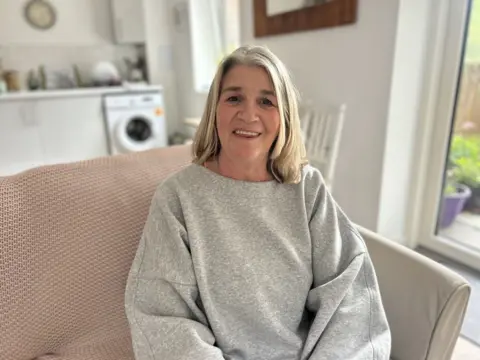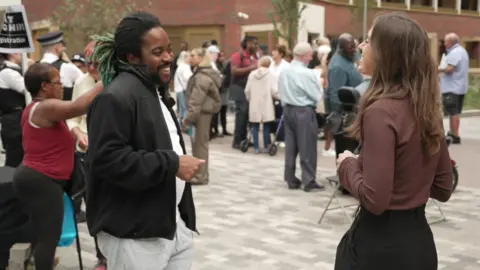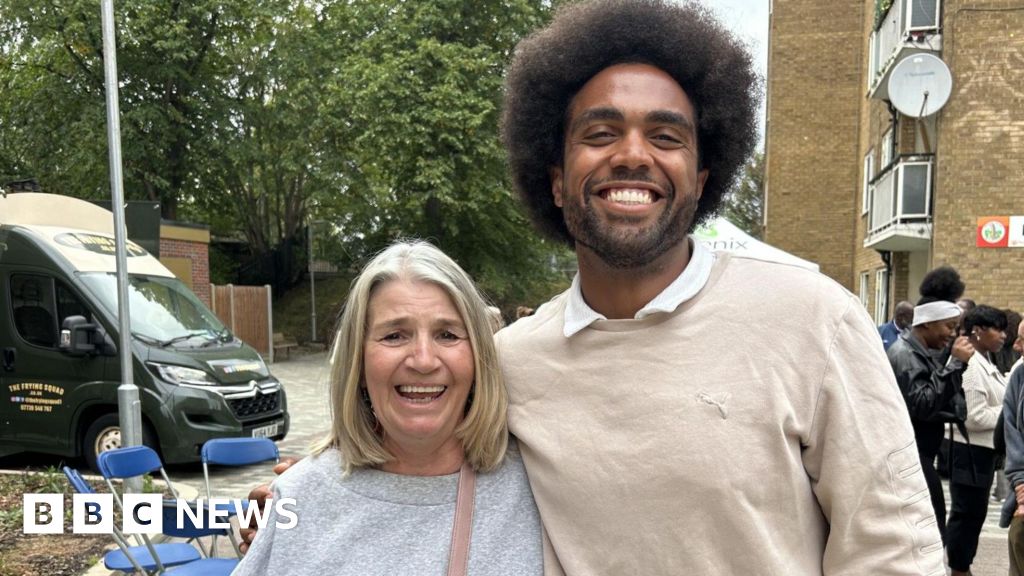Meghan OwenWork and money correspondent, BBC London
 BBC
BBC“It’s reassuring to know we’re not just a bunch of older people lumped into a building – that we’ve got young people around if we need to call on them for help,” says 60-year-old grandmother Claire.
She lives in Lewisham, south-east London, within one of the first intergenerational housing schemes in the country, with eight students as her neighbours.
Phoenix Community Housing (PCH), a not-for-profit resident-led housing association, has teamed up with the University of Goldsmiths to provide 30 affordable homes for residents aged 55 and above, along with two, four-bedroom homes for eight postgraduate students, all based in the same blocks.
In return for being “good neighbours”, including assisting older residents, offering company or organising activities like walks, students are charged a lower rent to live there.

One in 14 people aged 65 and over in the UK often feel lonely – the equivalent of 940,000 people – according to research published by Age UK in December 2024.
Those statistics are even more stark for London where it rises to almost one in 10 – the equivalent of 110,000 people.
Claire says her housing scheme is “perfect” for older people “who are isolated and are not seeing anyone apart from the doctor and hospital – to be able to see people, it’s lovely.
“We’re respectful of each other but also looking out for each other. The students bring an injection of youth,” she says.
Claire has lived in women’s hostels and supported housing for 10 years, but says it’s now nice to know there are students available to help.
“To have my own front door and in a secure block has made all the difference,” she explains.
“Every night it was like batten down the hatches and try and stay safe – it was hard.
“I feel like I’ve died and gone to heaven.”
‘It means a lot to me’
Post-graduate student Morley, 28, often organises walks or group-stretching for those based in the housing.
“Initially there is that hesitation because you’re living with a different generation but once you start you realise – even in the first week – it means a lot to those individuals and it means a lot to me too,” he says.
“I think that initial hurdle is something we need to get over.”
He adds he enjoys conversations about music with those older people in the housing, including discussions about garage and jungle music.
“They were there when it (the music) was being explored! I get a lot of knowledge from them. It’s been very rewarding and enriching,” he says.

Music student JJ says those living in the block are “really sweet and kind”.
“We did a walking group, we’re doing some painting and music sessions,” says the 22-year-old.
“A lot of my friends love being able to speak to some of the older residents.
“On Saturday I was coming home at 1am from a party and one of the older residents was on their balcony waving at me. It’s quite nice.”
Denise Fowler, chief executive of PCH, says the housing association was “overwhelmed” with people wanting to live there and is hoping to extend the scheme further.
“Intergenerational housing is a new idea but it’s really important in breaking down social isolation and building community, and we hope it will be a blueprint for other housing associations across the country,” she says.
‘Behind other countries’
Stephen Burke, from the United for All Ages think tank which promotes bringing older and younger people together, calls the UK “one of the most age-segregated countries in the world”.
“We are still behind other countries in terms of developing, for example, co-located care homes and nurseries where young and old can mix, and similarly with housing schemes. So there’s a lot that can be done.
“We’re learning from elsewhere, but… we do have some shining examples.”
He says the housing scheme in Lewisham helps to tackle “a crisis of affordable housing, particularly for young people, a crisis of loneliness, which affects not just older people, but also young people. And we also have an issue about age segregation, which has multiple impacts on our society”.
Stephen adds that there is an opportunity to reinvent the high street which could be used for intergenerational housing schemes.
“Part of the problem with age segregation is that town centres and city centres are largely dominated by young people, and older people tend to live in smaller towns and rural areas,” he explains.
“If we can bring people together and locate facilities for older and young people in city centres, then we’re going to create stronger communities.”
It’s not a typical housing situation, but both the older residents and the students have benefited from the arrangement in Lewisham.
Could we therefore see more intergenerational living in the future?

